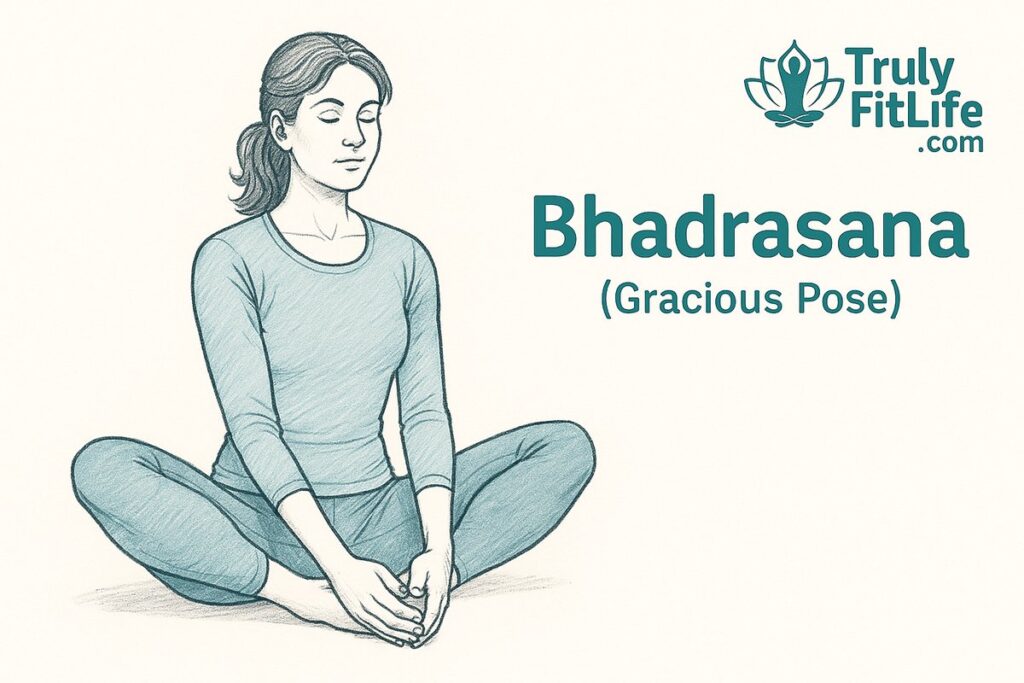
Introduction
Bhadrasana (Gracious Pose) is a classical seated yoga posture that appears in the Hatha Yoga Pradipika and Gheranda Samhita. The name comes from the Sanskrit word “Bhadra” meaning graceful, noble, or auspicious. This asana is primarily a meditative posture but also functions as a hip opener, grounding pose, and a starting position for pranayama or meditation.
Unlike Padmasana (Lotus Pose) or Siddhasana (Accomplished Pose), Bhadrasana is considered easier for beginners, making it suitable for people who want to start seated meditation practices without intense strain on their knees or hips.
Step-by-Step Instructions to Practice Bhadrasana – Gracious Pose
1. Preparation
- Sit on a yoga mat in Dandasana (Staff Pose), with your legs extended straight in front.
- Keep your spine upright and hands resting beside your body.
2. Foot Placement
- Bend your knees and bring the soles of your feet together.
- Draw the heels as close to the perineum as comfortable, letting your knees drop toward the floor.
3. Hand Position
- Hold your feet or ankles with both hands.
- Some traditions suggest catching the toes, while others recommend placing hands on the knees for grounding.
4. Alignment
- Keep the back straight, chest open, and shoulders relaxed.
- Let the knees naturally move downward with gravity — do not push them forcefully.
5. Breathing
- Breathe slowly and deeply.
- Focus your awareness at the navel or heart center.
6. Duration
- Beginners: Start with 1–2 minutes.
- With practice, extend to 5–10 minutes during meditation or pranayama.
Key Alignment Tips
- Keep spine upright — avoid slouching.
- Ensure knees move outward without strain.
- Engage thighs gently to prevent knee tension.
- Use a folded blanket under hips if knees are higher than waist.
Physiological & Psychological Benefits
🦴 Physical Benefits
- Opens the hips & groin: Improves flexibility in the inner thighs, hips, and pelvic region.
- Strengthens back muscles: Upright posture builds endurance in spinal erectors.
- Improves digestion: The gentle pressure on the abdomen stimulates digestive organs.
- Supports reproductive health: Traditionally said to benefit pelvic circulation.
- Prepares for meditation: Provides a steady seated base for longer sitting practices.
🧠 Mental & Emotional Benefits
- Calmness & Stability: Promotes relaxation and grounding.
- Focus & Concentration: Ideal posture for pranayama, mantra chanting, and meditation.
- Balances Energy: In yogic tradition, sitting in Bhadrasana helps channel energy upward through the spine.
Contraindications & Safety Tips
- ❌ Avoid if you have serious knee injuries or hip replacements.
- ❌ People with severe sciatica or lower back pain should practice with props.
- ⚠️ Pregnant women can practice with support but should avoid long holds.
- ⚠️ Never force knees down with hands; let gravity do the work.
👉 Modification: Place yoga blocks or pillows under each thigh for extra support.
Modifications & Variations
- Supported Bhadrasana: Sit on a folded blanket to reduce strain.
- Wall-Supported Pose: Sit against a wall for spinal alignment.
- Dynamic Butterfly Variation: Gently flap the knees up and down to warm up hip joints.
Drishti (Gaze Point)
- Nasagra Drishti (Tip of Nose) for calm focus.
- Or keep eyes gently closed during meditation.
Chakras Activated
- Muladhara (Root Chakra): Grounding and stability.
- Svadhisthana (Sacral Chakra): Enhances pelvic energy flow.
- Manipura (Solar Plexus Chakra): Supports digestive energy.
Practice Suggestions
- Best practiced in the morning for meditation.
- Can be used before pranayama, chanting, or visualization.
- If hips are stiff, warm up with gentle hip stretches first.
